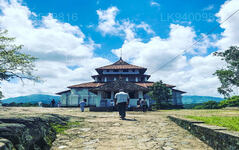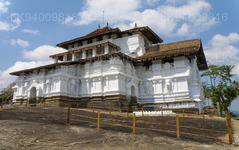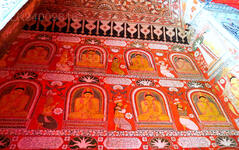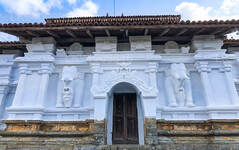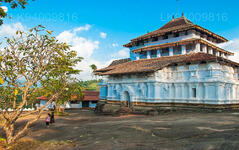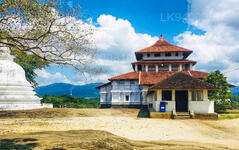
Cidade de Kandy
Kandy, uma cidade pitoresca no centro do Sri Lanka, é famosa por seu rico patrimônio cultural, festivais vibrantes e beleza cênica. Aninhada em meio a colinas verdejantes, abriga o Templo da Relíquia do Dente, Patrimônio Mundial da UNESCO, e oferece uma mistura cativante de história e esplendor natural.
Lankathilaka Viharaya
Lankathilaka Viharaya in Sri Lanka: The Great Temple of the Kings
Lankatilaka is Buddhist temple of the 14th century in the Hiyarapitiya village, from the Udu Nuwara area of Kandy district in Sri Lanka. This historical temple was built by the Gampola king, King Buwanekabahu the fourth (1341 – 1351AD), in 1344 AD. Gampola was a stronghold on the banks of Mahaveli River.
Lankathilaka Viharaya in Sri Lanka: Architectural Facts
- The temple was designed by the South Indian architect Sthapati Rayar.
- According to the opinions of researchers; the temple combines the design elements of the Polonnaruwa era architecture with that of Dravidian (India) and Indo-Chinese design. At the time of construction the temple was a four storied edifice of eighty feet, built on uneven bedrock using a granite based foundation.
- The temple structure is such that it radiates from the centre in the four cardinal directions, like a cross. Only then ground floor and part of the first floor of the original temple can be seen today, though the temple appears to have three stories from the outside.
- The thick outer walls of the Temple have beautifully sculpted arches and various sculptures making it a unique design of the 14th century.
Lankathilaka Viharaya in Sri Lanka: Sights when entering the Temple
- There are two directions of approach to the temple. One of them has abodes for Buddhist monks at the base of the rock.
- The premises also have many sights such as the huge rice storage bins, known as ‘Atuwa’ by the locals. The stairs begin in the premises of the abodes.
- The other method of approach is from the west of the temple.
- With two ways of approach come two different flights of stairs. One is the original flight built in the 14th century, while the other is more recent; built around 1913. The stairs are cut into the living rock of Pahangalla and provide a climber with beautiful views of the surrounding countryside.
- At the top of the old flight of stairs, the premises of the temple can be entered through a primitive stone door arch, created with three long pieces of rock affixed together.
Lankathilaka Viharaya in Sri Lanka: The Temple
The temple premises have three sectors; the actual temple building, the Dagoba or stupa and finally the Bo tree.
The temple like the flights of stairs has two entrances, leading to two different and disconnected sections in the same building. The main and most important sector is the eastern section, the Buddha Image House. The other is on the west, the the Temples of the Gods.
The Buddha Image House
- The Buddha Image House which is approached from the eastern entrance, right in front of the eastern flight of stairs, and has a Moonstone adorning the ground before the entrance.
- Def. Moonstone: A semi-circular piece of stone which stands at the foot of a flight of steps in most historical Buddhist buildings.
- Two balustrades carved with the Gajasinha or elephant headed lion hybrid design flank the short flight of stairs leading to the entrance archway of the temple.
- The outer archway has a Makara Torana or dragon figure with some unique characteristics that differentiate it from the usual Makara Toranas.
- On the wide inside side walls of the archway display wonderfully preserved paintings of lions. A pair of guardian statues stands close to the wooden door, which has several panels painted with creepers and various designs.
- The inside of the Buddha Image House is an art masterpiece in its entirety with the walls and ceiling completely covered in beautiful paintings dating back to the construction of the temple.
- The pigments used are mostly red, white, yellow and black; with red being the dominant colour possibly because ochre was a pigment that could last the ravages of time.
- The paintings depict the lives of the 24 former Buddhas on the walls, while the ceiling has an abstract flower design.
- The centrepiece of the Buddha Image House is a beautiful golden toned seated Buddha statue. Above the statue is another Makara Torana with sculptures of angels watching over.
Lankathilaka Viharaya in Sri Lanka: Rock Inscriptions
There are inscriptions cut into the rock surface on the temple premises. The inscriptions are both in Sinhala and Tamil, stating that the land was gifted to the Temple by the kings and describing other facilities offered to the temple.
The Lankatilaka Temple is a beautiful cultural heritage of Sri Lanka that has to be visited on a holiday to the country. This temple along with the Embekke temple remains one of the most architecturally advanced structures of the Gampola Kingdom era.
Sobre o distrito de Kandy
O distrito de Kandy está situado na província central do Sri Lanka. Um dos sete Patrimônios Mundiais do Sri Lanka, Kandy já foi o lar dos Reis Kandy de outrora no século XVI e uma fonte de toda a música, artes, artesanato e cultura do país. A cerca de 129 km de Colombo, Kandy está situada em um terreno montanhoso e todos os olhos são atraídos para o centro da cidade, onde o Lago Kandy forma uma característica encantadora. Kandy mantém grande significado religioso para o Sri Lanka, porque é nesta cidade encantadora que o Dalada Maligawa ou "Templo do Dente" está localizado, dentro do qual a relíquia sagrada do dente do Senhor Buda está bem guardada. O Jardim Botânico Real, Peradeniya, está situado a cerca de 5 km a oeste do centro da cidade em Peradeniya e é visitado por 1,2 milhão de pessoas por ano. É o maior jardim botânico da ilha. O Udawatta Kele (Floresta Udawatta) é um santuário protegido situado no coração da cidade, ao norte do Templo do Dente. Kandy é uma cidade de maioria cingalesa; há comunidades consideráveis pertencentes a outros grupos étnicos, como mouros e tâmeis. Kandy fica atrás apenas de Colombo no centro da economia do Sri Lanka. Muitas grandes cooperativas têm grandes filiais em Kandy e muitas indústrias, incluindo têxteis, móveis, tecnologia da informação e joias, são encontradas aqui. Muitos centros de pesquisa agrícola estão localizados na cidade. E uma fonte para toda a música, artes, artesanato e cultura do país. A cerca de 129 km de Colombo, Kandy está abrigada em um terreno montanhoso e todos os olhares são atraídos para o centro da cidade, onde o Lago Kandy forma uma característica encantadora. Kandy mantém grande significado religioso para o Sri Lanka, porque é nesta cidade encantadora que o Dalada Maligawa ou Templo do Dente está localizado, dentro do qual a relíquia sagrada do dente do Senhor Buda está bem guardada.
Sobre a Província Central
A Província Central do Sri Lanka é constituída principalmente por terrenos montanhosos. A província tem uma área de 5.674 km² e uma população de 2.421.148 habitantes. Algumas das principais cidades incluem Kandy, Gampola (24.730 habitantes), Nuwara Eliya e Bandarawela. A população é uma mistura de cingaleses, tâmeis e mouros. Tanto a capital montanhosa, Kandy, quanto a cidade de Nuwara Eliya estão localizadas na Província Central, assim como Sri Pada. A província produz grande parte do famoso chá do Ceilão, plantado pelos britânicos na década de 1860, após uma doença devastadora ter dizimado todas as plantações de café da província. A Província Central atrai muitos turistas, com cidades montanhosas como Kandy, Gampola, Hatton e Nuwara Eliya. O dente-de-templo ou Dalada maligawa é o principal local sagrado da província de Centrel. O clima é fresco e muitas áreas a cerca de 1.500 metros de altitude costumam ter noites frias. As encostas ocidentais são muito úmidas, com alguns locais recebendo quase 7.000 mm de chuva por ano. As encostas orientais fazem parte da zona meio seca, recebendo chuva apenas das monções do nordeste. As temperaturas variam de 24°C em Kandy a apenas 16°C em Nuwara Eliya, localizada a 1.889 m acima do nível do mar. As montanhas mais altas do Sri Lanka estão localizadas na Província Central. O terreno é predominantemente montanhoso, com vales profundos que o cortam. As duas principais regiões montanhosas são o Maciço Central e a Cordilheira Knuckles, a leste de Kandy.

